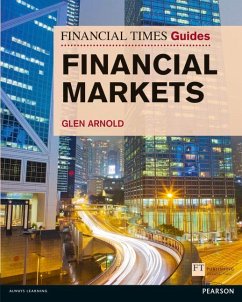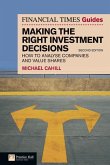From bestselling author Glen Arnold, this is a jargon-busting book that describes how financial markets work, where they are located and how they impact on everyday life. It assumes no specialised prior knowledge of finance theory and provides an authoritative and comprehensive run-down of the workings of the modern financial system.
Using real world examples from media such as the Financial Times, Arnold gives an international perspective on the financial markets with frequent comparisons in the workings of major financial centres such as the Bank of England and the City, the Federal Reserve System and Wall Street, the Japanese Central Bank, the European Central Bank and IMF and World Bank.
Product Description
From bestselling author Glen Arnold, this is a jargon-busting book that describes how financial markets work, where they are located and how they impact on everyday life. It assumes no specialised prior knowledge of finance theory and provides an authoritative and comprehensive run-down of the workings of the modern financial system.
Using real world examples from media such as the Financial Times, Arnold gives an international perspective on the financial markets with frequent comparisons in the workings of major financial centres such as the Bank of England and the City, the Federal Reserve System and Wall Street, the Japanese Central Bank, the European Central Bank and IMF and World Bank.
Backcover
Essential reading for those who work in finance, those who want to work in finance, and those who want to know what people in the City are doing with their money.
Jamie Lowry, Fund Manager, Schroders Investment Management
For anyone wishing to work in the financial industry, this is up-to-date and comprehensive coverage of how the modern financial markets operate.
Dr Kenjiro Hori, Lecturer in Economics / Programme Director BSc Financial Economics with Accounting, University of London
The Financial Times Guide to the Financial Markets provides a broad yet firm understanding of financial markets. It covers a wide range of key up-to-date topics including useful economic analysis of the financial crisis. The guide uses up-to-date statistics as well as offering clear explanations on the technical aspects of banking and finance.
Dr Hui-Fai Shing, Economics Department, Royal Holloway University
How do financial markets operate? And how do movements in those financial markets impact on you and others? How can you make sense of all the different types of financial instruments into which people put their money?
Comprehensive and clear, The Financial Times Guide to the Financial Markets is the ultimate guide to the instruments, institutions and products that make up our global financial system. Using examples and case studies, Glen Arnold covers everything you need to know to gain a thorough understanding of modern finance and how the markets work. This easy to read, jargon-busting book includes:
An overview of how the financial industry really operates and the effects its behaviour and crises have on you
A comprehensive run down of the securities available and how to use them
Comparisons between the major financial centres of the world
What the future holds for the financial markets
Preface
Author's acknowledgments
Publisher's acknowledgements
Chapter 1 The purpose of financial markets
Chapter 2 An overview of the markets and institutions
Chapter 3 Banking: retail and corporate
Chapter 4 Investment banking
Chapter 5 Other types of banking
Chapter 6 Central banking
Chapter 7 Pooled investment funds
Chapter 8 Insurance
Chapter 9 Money markets
Chapter 10 Bond markets governments and corporate
Chapter 11 Bond markets - the more exotic
Chapter 12 Equity markets
Chapter 13 Raising share capital
Chapter 14 Futures markets
Chapter 15 Options and swaps
Chapter 16 Foreign exchange markets
Chapter 17 Hedge funds and private equity
Chapter 18 Regulation of the financial sector
Chapter 19 The financial crisis
Index
"Essential reading for those who work in finance, those who want to work in finance, and those who want to know what people in the City are doing with their money." Jamie Lowry, Fund Manager, Schroders Investment Management "For anyone wishing to work in the financial industry, this is up-to-date and comprehensive coverage of how the modern financial markets operate." Dr Kenjiro Hori, Lecturer in Economics / Programme Director BSc Financial Economics with Accounting, University of London "The Financial Times Guide to the Financial Markets provides a broad yet firm understanding of financial markets. It covers a wide range of key up-to-date topics including useful economic analysis of the financial crisis. The guide uses up-to-date statistics as well as offering clear explanations on the technical aspects of banking and finance." Dr Hui-Fai Shing, Economics Department, Royal Holloway University How do financial markets operate? And how do movements in those financial markets impact on you and others? How can you make sense of all the different types of financial instruments into which people put their money? Comprehensive and clear, The Financial Times Guide to the Financial Markets is the ultimate guide to the instruments, institutions and products that make up our global financial system. Using examples and case studies, Glen Arnold covers everything you need to know to gain a thorough understanding of modern finance and how the markets work. This easy to read, jargon-busting book includes: An overview of how the financial industry really operates and the effects its behaviour and crises have on you A comprehensive run down of the securities available and how to use them Comparisons between the major financial centres of the world What the future holds for the financial markets
Using real world examples from media such as the Financial Times, Arnold gives an international perspective on the financial markets with frequent comparisons in the workings of major financial centres such as the Bank of England and the City, the Federal Reserve System and Wall Street, the Japanese Central Bank, the European Central Bank and IMF and World Bank.
Product Description
From bestselling author Glen Arnold, this is a jargon-busting book that describes how financial markets work, where they are located and how they impact on everyday life. It assumes no specialised prior knowledge of finance theory and provides an authoritative and comprehensive run-down of the workings of the modern financial system.
Using real world examples from media such as the Financial Times, Arnold gives an international perspective on the financial markets with frequent comparisons in the workings of major financial centres such as the Bank of England and the City, the Federal Reserve System and Wall Street, the Japanese Central Bank, the European Central Bank and IMF and World Bank.
Backcover
Essential reading for those who work in finance, those who want to work in finance, and those who want to know what people in the City are doing with their money.
Jamie Lowry, Fund Manager, Schroders Investment Management
For anyone wishing to work in the financial industry, this is up-to-date and comprehensive coverage of how the modern financial markets operate.
Dr Kenjiro Hori, Lecturer in Economics / Programme Director BSc Financial Economics with Accounting, University of London
The Financial Times Guide to the Financial Markets provides a broad yet firm understanding of financial markets. It covers a wide range of key up-to-date topics including useful economic analysis of the financial crisis. The guide uses up-to-date statistics as well as offering clear explanations on the technical aspects of banking and finance.
Dr Hui-Fai Shing, Economics Department, Royal Holloway University
How do financial markets operate? And how do movements in those financial markets impact on you and others? How can you make sense of all the different types of financial instruments into which people put their money?
Comprehensive and clear, The Financial Times Guide to the Financial Markets is the ultimate guide to the instruments, institutions and products that make up our global financial system. Using examples and case studies, Glen Arnold covers everything you need to know to gain a thorough understanding of modern finance and how the markets work. This easy to read, jargon-busting book includes:
An overview of how the financial industry really operates and the effects its behaviour and crises have on you
A comprehensive run down of the securities available and how to use them
Comparisons between the major financial centres of the world
What the future holds for the financial markets
Preface
Author's acknowledgments
Publisher's acknowledgements
Chapter 1 The purpose of financial markets
Chapter 2 An overview of the markets and institutions
Chapter 3 Banking: retail and corporate
Chapter 4 Investment banking
Chapter 5 Other types of banking
Chapter 6 Central banking
Chapter 7 Pooled investment funds
Chapter 8 Insurance
Chapter 9 Money markets
Chapter 10 Bond markets governments and corporate
Chapter 11 Bond markets - the more exotic
Chapter 12 Equity markets
Chapter 13 Raising share capital
Chapter 14 Futures markets
Chapter 15 Options and swaps
Chapter 16 Foreign exchange markets
Chapter 17 Hedge funds and private equity
Chapter 18 Regulation of the financial sector
Chapter 19 The financial crisis
Index
"Essential reading for those who work in finance, those who want to work in finance, and those who want to know what people in the City are doing with their money." Jamie Lowry, Fund Manager, Schroders Investment Management "For anyone wishing to work in the financial industry, this is up-to-date and comprehensive coverage of how the modern financial markets operate." Dr Kenjiro Hori, Lecturer in Economics / Programme Director BSc Financial Economics with Accounting, University of London "The Financial Times Guide to the Financial Markets provides a broad yet firm understanding of financial markets. It covers a wide range of key up-to-date topics including useful economic analysis of the financial crisis. The guide uses up-to-date statistics as well as offering clear explanations on the technical aspects of banking and finance." Dr Hui-Fai Shing, Economics Department, Royal Holloway University How do financial markets operate? And how do movements in those financial markets impact on you and others? How can you make sense of all the different types of financial instruments into which people put their money? Comprehensive and clear, The Financial Times Guide to the Financial Markets is the ultimate guide to the instruments, institutions and products that make up our global financial system. Using examples and case studies, Glen Arnold covers everything you need to know to gain a thorough understanding of modern finance and how the markets work. This easy to read, jargon-busting book includes: An overview of how the financial industry really operates and the effects its behaviour and crises have on you A comprehensive run down of the securities available and how to use them Comparisons between the major financial centres of the world What the future holds for the financial markets








